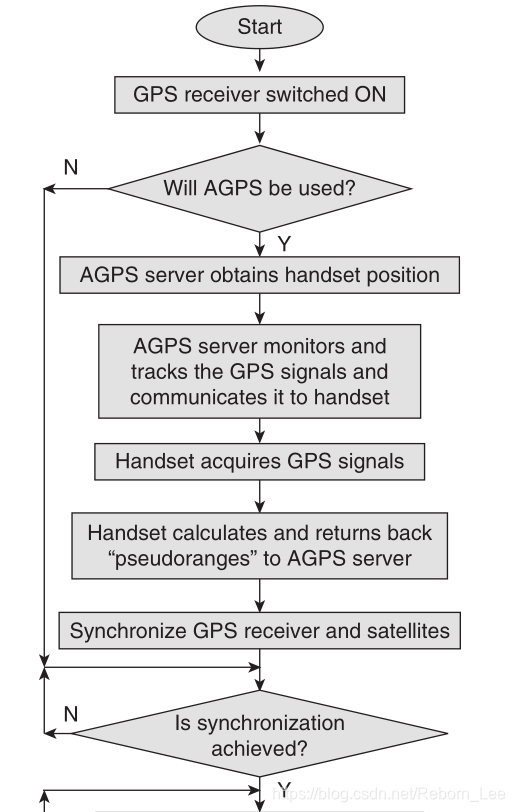【 Notes 】 AGPS or Assisted GPS
Assisted Global Positioning System ( AGPS or Assisted GPS )
GPS operation was summarized in the previous section. Although GPS is a very robust positioning system, there remains the problem of time to first fix ( TTFF ) or “ cold start ” ; that is, GPS receivers are first turned on, they need a long time (on the order of 30 seconds to a few minutes) to acquire satellite signals, to navigate data, and to localize. This time duration varies with the location of the receiver and the surrounding interference. In order to address this problem, AGPS has been developed.
GPS操作在前一节中进行了总结。 尽管GPS是一种非常强大的定位系统,但仍然存在首次定位时间(TTFF)或“冷启动”的问题; 也就是说,GPS接收器首先打开,它们需要很长时间(大约30秒到几分钟)来获取卫星信号,导航数据和定位。 该持续时间随接收器的位置和周围干扰而变化。 为了解决这个问题,已经开发了AGPS。
AGPS consists of
1. a wireless handset with a scaled - down version (with respect to the power requirements, computational capabilities, etc.) of a GPS receiver;
2. an AGPS server with a reference GPS receiver that can simultaneously monitor and track the same satellites as the wireless handset; and
3. a wireless network infrastructure consisting of base stations and a mobile switching center.
AGPS包括
1.具有缩小版本(关于GPS接收器的功率要求,计算能力等)的无线手机;
2.具有参考GPS接收器的AGPS服务器,其可以同时监视和跟踪与无线手机相同的卫星; 和
3.由基站和移动交换中心组成的无线网络基础设施。
The AGPS server obtains handset position from the mobile switching center and can locate the cell of the handset and even the sector of the handset within a set if directional antennas are used at the cell base stations [1] . Because the AGPS server monitors and tracks the GPS satellites, it can predict the satellites that are sending the signals to the handset at any given point of time. Thus, the AGPS server can communicate the satellite information to the handset.
AGPS服务器从移动交换中心获得手机位置,并且如果在小区基站使用定向天线,则可以定位手机的小区甚至手机的扇区[1]。 由于AGPS服务器监视和跟踪GPS卫星,它可以预测在任何给定时间点向手机发送信号的卫星。 因此,AGPS服务器可以将卫星信息传送到手机。
This enables the handset to acquire GPS signals quickly when it is fi rst turned on, reducing TTFF from minutes to less than a second. Once the satellite signals are acquired by the handset, it calculates the distances to satellites without clock synchronization. These satellite distances are sent back to the AGPS server for further computation, as can be seen in Figure 1.3 a. Thus, the AGPS server also shares the computational load of the handset, reducing the handset battery power consumption.
这使得手机能够在首次开启时快速获取GPS信号,从而将TTFF从几分钟减少到不到一秒。 一旦手机获取卫星信号,它就会在没有时钟同步的情况下计算到卫星的距离。 这些卫星距离被发送回AGPS服务器以进行进一步计算,如图1.3a所示。 因此,AGPS服务器还共享手机的计算负荷,降低了手机电池的功耗。
Figure 1.3 a


文章来源: reborn.blog.csdn.net,作者:李锐博恩,版权归原作者所有,如需转载,请联系作者。
原文链接:reborn.blog.csdn.net/article/details/84075649
- 点赞
- 收藏
- 关注作者


评论(0)